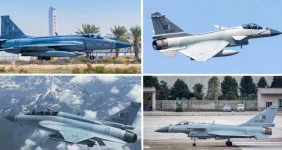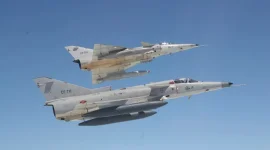- Views: 2K
- Replies: 7
Pakistan's Navy (PN) is reportedly evaluating the acquisition of Chengdu J-10CE fighter jets from China, a move perceived as a strategic effort to modernise its maritime defence capabilities.
This consideration arises as Pakistan prepares to retire its aging Mirage-III aircraft and potentially counter India's recent steps to enhance its naval air power with the French-made Dassault Rafale M fighter.
The J-10CE, classified as a 4.5-generation multirole combat aircraft, is being considered to replace the outgoing Mirage-III jets. While operated by the Pakistan Air Force (PAF), a number of these older Mirage aircraft have been assigned to support PN maritime security operations.
A key uncertainty remains whether the potential new J-10CE aircraft would be operated directly by the Navy, or if the Air Force would manage an expanded fleet to cover maritime surveillance and defence missions over the Arabian Sea.
This development follows India's decision, approved in July 2023, to acquire 26 Rafale M fighters specifically for its naval forces. The Rafale M is designed for aircraft carrier operations, such as from the INS Vikrant, and features advanced sensor suites and long-range weapons like the Meteor air-to-air missile.
This purchase significantly strengthens India's ability to project air power across the Indian Ocean Region, including the Arabian Sea, which is crucial for Pakistan's maritime trade and security.
In response, Pakistan appears focused on enhancing its own aerial capabilities over water. The J-10CE, the export variant of China's J-10C, offers modern features including agility, advanced avionics, and compatibility with potent munitions like the PL-15 long-range air-to-air missile.
Introducing the J-10CE into a maritime role could improve Pakistan's capacity for anti-ship missions and air defence over the sea. This potential procurement highlights Pakistan's continued reliance on its close ally, China, for advanced military hardware to balance regional military developments.
The Mirage-III fighters, originally acquired from France starting in the 1960s, have served the PAF for decades. Although some were upgraded under the Retrofit of Strike Element (ROSE) programme to improve avionics and strike capabilities, the fleet is nearing the end of its operational life due to age, maintenance challenges, and increasing obsolescence, making retirement unavoidable.
The PN's potential interest in the J-10CE suggests a need for a modern replacement capable of performing similar maritime protection duties. The J-10CE is equipped with an Active Electronically Scanned Array (AESA) radar (with reports suggesting Pakistan's version may use the Italian Grifo-E) and can carry anti-ship missiles.
Its versatility as a multirole platform makes it suitable for both air-to-air combat and strike missions, crucial for safeguarding Pakistan's coastline and Exclusive Economic Zone (EEZ).
A central question remains regarding the operational command structure for these jets. Historically, the PN has depended on the PAF for fixed-wing air support, with PAF pilots and ground crews operating the Mirages assigned to maritime tasks. This arrangement could continue, potentially involving the PAF acquiring more J-10CEs to add to its existing squadron (No. 15 "Cobras," inducted in March 2022) specifically for naval support roles.
Alternatively, the PN might pursue establishing its own organic fighter wing, which would represent a significant shift in its operational doctrine. While the J-10CE's capabilities and potential support from China could make this option attractive, especially as the PN seeks greater autonomy, it would demand substantial investment.
Developing the necessary infrastructure, pilot training programmes, and logistical support would present considerable financial challenges, particularly given Pakistan's ongoing economic constraints.


